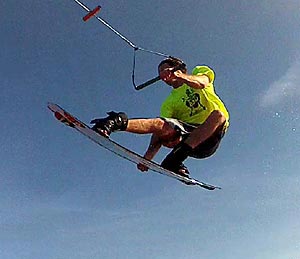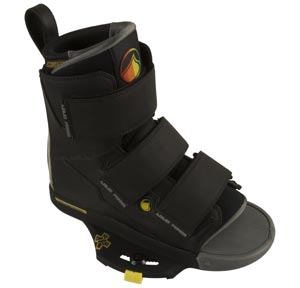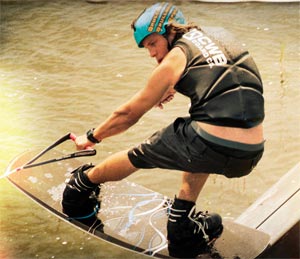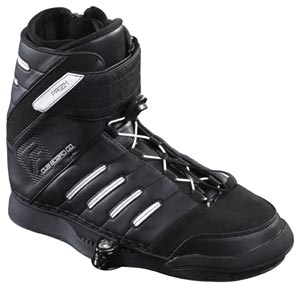|
The Case for Open-Toe Bindings
by Tim Walters
Like many wakeboarding debates, the open-toe vs. closed-toe binding argument boils down to one thing: personal preference. Do you prefer to hide your toes or show them off?
Closed-toe bindings were originally introduced in 2006 (if you don’t count the Fulltilt Sub Rosa from the late 90’s) by a few companies. The industry-wide “closed-toe craze” promised improved heel/toe response, more specific sizing, as well as warmer feet for winter riding. In 2007, nearly every wake manufacturer had closed-toe options in their line, and some (Slingshot, for example) didn’t even offer an open-toe option. Fast forward to present day and you will see how each company has elected to expand their open-toe offerings…and for good reason.

Some of the advantages of open-toe boots are broad sizing, a price range for any budget and, believe it or not, improved heel/toe response! Wait, open-toe offers better performance? Yes! Think about it. The toe box of a closed-toe boot is fixed and unable to move or mold to your foot. By allowing the toe box to be open, you allow the materials of the boot the mobility necessary to fit the toe securely. If toe-lift is a concern, you can wrench down a Velcro strap over your toes much better in an open-toe boot. Ask the European cable riders what they think about Bob Soven’s new open-toe boot. You will hear them say that it is more locked-down over the toes than any closed-toe boot.
To further discredit the notion that you need to buy a closed-toe boot for superior performance, just watch Aaron Reed take a 360 to the flats off a double up at Brostock, or what the boys are doing in Noisia Vision. These wakeskaters are not slowed down by any measure of toe-lift as they are obviously not even connected to the board. If they were to strap in, they would probably choose a closed-toe boot because they prefer that type of enclosure, but not because that type of bindings offers anything better.
For wakeboarders on a budget, open-toe bindings are less expensive and offer a fit that works for a broad range of sizes. Sure, I love selling a $429 pro model boot that has a size-specific fit, but I also love introducing new people to the sport who recently bought a $329 package that comes with a size 8-12 binding that the whole family will enjoy behind their 1980’s outboard boat. Any pro rider who is worth a darn can still hit their 900’s on a single zone lace-up open-toe, because I know a bunch of amateurs who can!

At the end of the day, it comes down to personal preference. I feel that my thin, narrow foot fits better in an open-tow Liquid Force Vantage boot. I can hold down the front of my foot with the Velcro straps and I am allowed the mobility to poke out the things I want to poke out (pun intended).
Rebuttal
by Kaesen Suyderhoud
Tim, you can trust me when I say I don't do something if it's "cool" or if anyone else is doing it. I would ride an open-toe binding if it helped my riding in any way more than a closed-toe. Hell, I used to ride open-toe bindings. We all did. You bring up good points, but not good enough to convince me to make the switch back over.
For starters, you bring up the broad sizing for all your wakeboarders’ needs. Yes, you and your buddies with similar size feet will have a blast sharing bindings, but make sure you bring extra soap for the guy with the size 12's trying getting his feet in only to have his toes hanging off the end of the padding and stretching out your new bindings. Then the size 8 guy can go next just to keep coming up on the swim step to put his feet back in after each fall. Sure it's great you gave them a good deal on the set up, but if these people are motor boating and riding behind a 1980 outboard, they most likely don't care about responsiveness in a boot or follow anything about this industry for that matter.
This debate is clearly to the people who care enough about the sport to be reading this. There are cheaper-priced closed-toe boots out there that aren't just a pro model, so if you are one of the few in this sport on a tight budget, there is still hope. You can even go to your local board shop or, if you are lucky enough, your local wake park to demo a pair. The closed-toe boot that I ride comes in a small, medium, large, XL and XXL. No specific shoe size needed since it’s the same as open-toe size ranges.
Wakeboard companies that are reading this, maybe try to include more reasonably-priced closed-toe package deals to your line for boat shows and board shops. What were you doing selling only one set up to a whole family anyway? That's not helping the growth of this industry out at all. Bad sales move if you ask me.
As for this “more responsive” talk of yours, I couldn't disagree with you more. You are out of your mind if you think your lowest Velcro strap cinched down as tight as possible does anything. I can tighten the crap out of the lower section of my closed-toe boots as well. It's the toe lift from open-toe bindings that lowers the response. Unless your overlay goes over your toes somehow, then I guess you get the best of both worlds. If your toes are swimming in your closed-toe boots, then get a different pair. Until then there is no way to get the same amount of responsiveness.
As far as this "pro that's worth a darn that can do a 900 in anything," it’s a no brainer. I can do all my tricks in an open-toe as well. Will it be more comfortable and controlled? No, and that's why I don't use them.
The one part I do agree with you is the personal preference. Yes, we could go back and forth on this all day, but it comes down to what your foot likes best. For me there is nothing better than the comfort and control of a closed-toe boot, not to mention the neoprene shoe inside of mine keeping my feet safe and sound on my walk back to the start of a sketchy winch spot or the dock at a wake park. I just hope that if the people reading this far into a topic about this little sport we call wakeboarding, then they care enough about the progression of their riding and the sport to give closed-toe boots a solid attempt before their next binding purchase. |
|
The Case for Closed-Toe Bindings
by Kaesen Suyderhoud
From the beginning of our sport we have thrived on progression. Whether it’s through athleticism or production of the gear, we put our time and life into making what we do better and we won’t ever stop. In this situation, we talk about the development of wakeboard bindings and how far they have come since their debut on a surfboard to what makes the closed-toe version of bindings the best choice for your wakeboarding.
When you look back at the beginning of binding technology, it was a few Velcro straps and a little pad for your foot. This is because the sport was being raised from surfing. Since then, it’s been slowly building off the first design by adding wraps around the entire foot to adding laces. It wasn’t until 2006 that the modern closed-toe boot was introduced into our sport. This was because the sport had been paying a lot more attention to snowboarding, which affected more than just the boots. It affected the styles of riding, tricks, rails, winching and mostly the wake parks, which all got more popular and accepted into the sport around that time.

What the closed-toe brought to the table was more responsiveness from the movement of your toes to help with the overall control of your board. So instead of moving your toes up, down and all around when edging in an open-toe binding with no reward, your toes will actually help move the board how you want with ease from the toe piece over them. But just like any brand new technology, it is never right the first time.
The first generation closed-toe toe pieces were just a thin stretchy neoprene that acted more as a toe warmer in the colder months of riding than anything. When the stiffer toe pieces and more boot style look came into play with the newer models, it really made an impact in the sport and began to dominate. Not only was the technology working and catching on, but the image helped progress the sport into a more socially-accepted look for the direction it was heading.
Now everyone knows the term, “if it ain’t broke, don’t fix it,” but if we all followed that then we would all be walking around town in old roman sandals or something. This is just the way the world of evolution works. It’s in every product of every sports company out there and, without it, we wouldn’t progress as athletes. What the closed-toe boots have progressed into is based on comfort, preference and, of course, responsiveness. Comfort, by using the right materials and proper padding, preference for the amount of support and stiffness you want and responsiveness when you use the stiffness plus adding the closed-toe.

The reasons why closed-toe boots are better than open-toe can be debated all day, but in actuality there is no debate because it’s what you decide is better on the water. Just keep in mind that most people riding nowadays ride with closed-toe boots and 95% of the professionals have chosen to go closed-toe as well, so it’s got to be more than just looking cool. It’s because closed-toe bindings help you ride better and give you more control of your board. With that, it gives you no reason to lower your riding standards with open-toe bindings anymore. This will bring about the eventual death of open-toe bindings.
Rebuttal
by Tim Walters
Kaesen’s case for closed-toe bindings is very interesting. Let me summarize his three main points. First, wakeboarding should be like snowboarding. Two, open-toe bindings are old school Skurfer technology. Three, pros wear them and so should you to be "cool."
As far as wakeboarding drawing its inspiration from snowboarding, I argue that it is the opposite. The snowboard industry now offers reverse camber (AKA rocker) boards, Velcro boots, true twin shapes (just like wakeboards and unlike most surfboards and skate boards) and the snow pros are looking over their shoulders to see what Raphael Derome and Kevin Henshaw are doing on rails. So clearly snowboarding is following the trends of wakeboarding. Let’s not even open the snow bindings on wakeboards can of worms! :)
Next, I agree with the evolution of design and technology argument. I know I would have less fun riding in old surf sandal straps. Again, I point to the evolution of high-end pro model boots when I refer to the 2012 Bob Soven boot… Oh my gosh, an open-toe!
Lastly, many pros do wear closed-toe. However, pros also grab tindy, slob and zeach slide rails all over the place and that doesn’t give them cool points. You get the idea?
Like I said before, it all comes down to personal preference. Some people need open-toe boots to share with family and friends and some people need to feel cool when they jam their toes every time they come up short on a trick. At the end of the day, more open-toe boots are sold than closed-toe…I have access to the numbers.
|

wakeboardertj
sdlfwake
I don't think though that the argument for more or less sensitivity can be summed up by saying that closed or open toe technology gives you more control. I don't believe that it is a fact that the closed or open toe gives you more response. I think it comes down to a base plate or mounting system that is really what gives you more feeling and control of your board. To speak Tim's/liquid force's language, look at the difference between the IP6 and IPX chassis. I have a pair of OT Transits with the IP6 that have more heel and toe lift than the IPX because of warping from over-tightening the mounting hardware. The new vantage open-toes have the same responsiveness as my Watson CT's and are just as comfortable, although I do prefer the Watson CT because my little piggies get cold.
As far as toe lift, I don't buy it. There is no way to prove that CT's have less toe lift than OT's other than the biased feeling of the rider. I don't feel any more toe lift in Vantage OT's than I do in Watson CT's, nor do I feel less. I do however have blood blisters under my toenails from slamming my toes into the toe caps of a pair of O'brien Decade close-toes that fit me perfectly.
I think that the CT option looks cool and are warm and comfy for sure, but the OT option offers just as much style and comfort.
I do think though, that Tim offered up some good points about open toe bindings, while not discrediting closed toes. Kaesen, came out guns blaring against the open toe treating it as an archaic technology that, contrary to what he said in his rebuttal, wasn't cool, so why bother.
The choice is yours, based on preference and I don't believe it's the toe-cap that makes the difference. Even though my daily driver has closed toes, I still enjoy the wind between my toes now and then as long as my base-plate stays flat.
joshbank
brhanley
janzy
ak4life
Like everyone else, I used to ride OT (during my first 5 years or so worth of riding, went through 3 pairs -- first one borrowed, 2nd and 3rd, owned). When CT came out, it immediately made sense to me -- how often do you see people wearing open toe sandals engaged in any kind of a sport where control matters?
My first CT binding was the LF Shane, I immediately felt more control, but didn't care for sometimes stabbing my toes on sketchy landings. Plus they looked like clown boots. :-) After a couple of years switched to Slingshot CTs (with booties, heat molded to the foot). No more stabbing toes -- the control and comfort (and extra warmth in the winter) were incredible. After a couple of years, after the second time I ripped the laces (plus tired for dealing with three laces per boot), I switched to Ronix Relics, same comfort as the Slingshots (heat molded lining again), but just two laces per boot, plus no booties to forget at home, plus lighter binding than any other I've ever worn. After a couple of years, still love these Relics, no plan to switch to anything else till they're toast.
Hooray for closed toe bindings!
ak4life
IMO, the " biased feeling of the rider" is all that matters, however, I've got old riding pics of me and my friends where you can clearly see toes curled upwards on some jumps.
robandrus